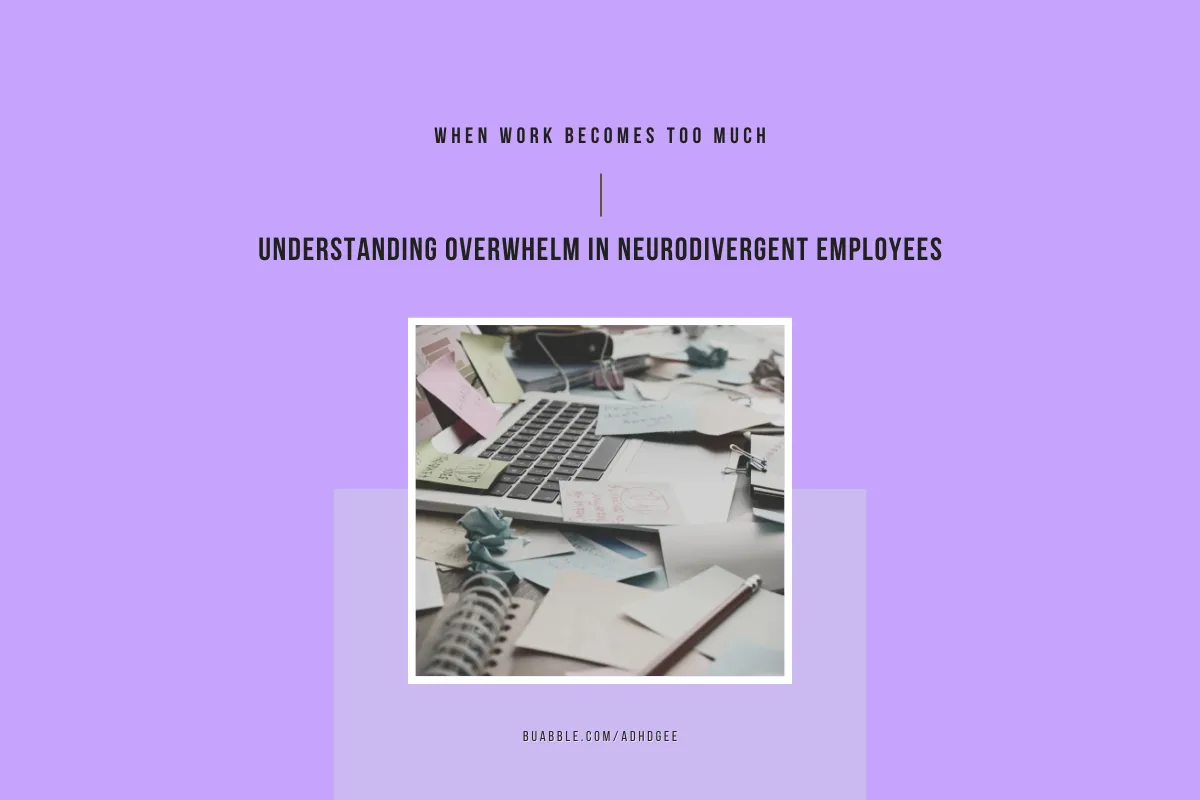
When Work Becomes Too Much: Understanding Overwhelm in Neurodivergent Employees
When Work Becomes Too Much: Understanding Overwhelm in Neurodivergent Employees
It's 2pm on a Wednesday, and Jiayu sits frozen at her desk, staring at seventeen open browser tabs while her colleagues' conversations buzz around the open office. The fluorescent lights feel like strobe lights, her email inbox shows 47 unread messages, and her brain simply won't cooperate with the project deadline looming overhead. For Jiayu, and millions of other neurodivergent employees, this scenario represents more than just a stressful day. It reflects a reality where 78% of neurodivergent workers report feeling overwhelmed at work, signaling a workplace crisis that demands urgent attention.
When we examine workplace overwhelm through a neurodivergent lens, we're looking at experiences that go far beyond typical work stress. Research demonstrates that neurodivergent employees, those with conditions like ADHD, autism, dyslexia, and other neurological differences, face unique challenges that can trigger intense overwhelm when workplace environments aren't designed with their needs in mind.

The Many Faces of Neurodivergent Overwhelm
ADHD: When Executive Function Meets Workplace Demands
For employees with ADHD, overwhelm often manifests through executive function challenges that make standard workplace tasks feel insurmountable. Research shows that employees with ADHD experience higher levels of job burnout, with executive function deficits serving as a key mechanism in this relationship. Adults with ADHD are generally 30 to 40 percent behind their peers in transitioning from one executive function to the next, meaning age-appropriate workplace expectations can feel overwhelming.
This might look like Maria, a marketing coordinator, who receives five different projects on Monday morning but cannot determine which to prioritise. Her brain craves the dopamine hit of switching between tasks, yet each transition costs precious mental energy. She becomes chronically anxious and feels overwhelmed and behind, not knowing which project to start and often jumping from task to task or avoiding work altogether. The constant mental effort required to manage time, organise materials, and maintain focus in an environment designed for neurotypical brains creates a perfect storm for overwhelm.
Autism: Navigating Sensory and Social Complexities
For autistic employees, overwhelm frequently stems from sensory overload, where too much sensory information in the environment, such as large and loud work environments, left participants feeling overwhelmed. But sensory challenges represent just one layer of potential overwhelm.
Autistic individuals may become very overwhelmed when in a meeting with just ten people, especially when people are talking rapid fire. The combination of processing multiple voices, interpreting social cues, and managing the sensory environment of a conference room can exceed their capacity to cope. Additionally, many traditional workplaces fail to accommodate some of the more common challenges employees with autism face, including anxiety and sensory problems.
Dyslexia: The Hidden Struggle with Information Processing
Dyslexic employees face overwhelm that's often invisible to colleagues and managers. The impact includes things such as low self-esteem, burnout, organisation and time management skills, with individuals getting stuck in a cycle of wanting to do their job well (low self-esteem) and not wanting to write the blog (overwhelming anxiety about language).
In today's fast-paced work environment, employees are expected to perform tasks with speed and accuracy while under pressure. For individuals with dyslexia, this can lead to anxiety and stress as they struggle with difficulties in working memory, auditory memory, organisation, planning, time management, sequencing, and following processes. The constant cognitive load of processing written information differently can create cumulative stress that builds into overwhelm.
The Ripple Effects: Productivity, Teams, and Performance
Understanding the True Impact
When neurodivergent employees become overwhelmed, the effects extend far beyond individual discomfort. Unmanaged sensory overload can lead to serious health risks including burnout, immune dysfunction, and heart complications, with research showing that people with chronic stress responses are at higher risk of cardiovascular disease due to long-term overactivation of the nervous system.
Recent research reveals that 68% of neurodivergent workers struggle with dealing with criticism and 64% with handling office politics, with this group being twice as likely to disagree that conflict resolution processes at work meet their needs compared to neurotypical colleagues. These statistics paint a picture of employees operating in survival mode rather than thriving mode.
The Productivity Paradox
Here's what overwhelm does NOT mean: that neurodivergent employees are less capable, less intelligent, or less valuable to organisations. Research suggests that teams with neurodivergent professionals in some roles can be 30% more productive than those without them. The key lies in creating conditions where their unique cognitive strengths can flourish rather than forcing them to operate in environments that trigger overwhelm.
Companies that have adapted their hiring and workplace practices to be more inclusive of neurodivergent employees report increased productivity, improved work quality, enhanced innovation, and higher employee engagement. The challenge isn't neurodivergent employees themselves. It's workplaces that haven't evolved to support neurological diversity.
Recognising the Warning Signs: For Neurodivergent Employees
Early Detection Strategies
The most effective approach to managing overwhelm starts with recognition. Self-knowledge, learning how to recognise and act on the early signs of autistic burnout (for example by cancelling social plans to have more rest), having an autism diagnosis, and understanding one's own patterns of behaviour and feelings, serves as a crucial first line of defence.
Watch for these patterns:
Increased sensitivity to sounds, lights, or textures that normally don't bother you
Difficulty making decisions about simple tasks like what to eat for lunch
Finding yourself avoiding colleagues or declining meeting invitations
Physical symptoms like headaches, stomach issues, or sleep disruption
Feeling like you're "masking" or pretending more than usual
Tasks that used to feel manageable now seeming impossible
Prevention Strategies That Work
Create Your Sensory Safety Plan: Identify potential triggers such as loud noise levels, non-adjustable lighting, strong smells, and crowded workspaces. Map out your workspace to identify both stressors and refuges.
Build in Recovery Time: Accommodations can help with planning, sticking to a routine, and setting boundaries at work. This might mean blocking out 15 minutes between meetings or taking lunch breaks in quiet spaces.
Leverage Your Strengths: Employers should explore with neurodivergent employees how they can use their strengths at work. If you excel at pattern recognition, advocate for projects that utilise this skill. If you thrive in structured environments, request clear guidelines and expectations.
Develop Communication Scripts: Prepare language for advocating for your needs. Practise saying things like, "I work best when I can review meeting agendas in advance" or "Could we follow up on this conversation via email so I can process the information fully?"
When Overwhelm Has Already Hit
Implement Immediate Damage Control: During overwhelming episodes, the person may become unresponsive, withdrawn, or exhibit signs of extreme fatigue. Have a plan for stepping away from stimulating environments when possible.
Use the "Minimum Viable Day" Approach: When overwhelmed, focus only on absolute essentials. What's the smallest version of productivity that still maintains your professional responsibilities?
Communicate Proactively: Let trusted colleagues or supervisors know you're experiencing a challenging period. Most people respond better to transparency than to unexplained changes in performance.
Leading Through Understanding: Guidance for Managers
Recognising Overwhelm in Your Team
Signs that an employee might be struggling include difficulties with time management, organisation, reading comprehension, or verbal communication. But overwhelm can be subtle: watch for changes in typical patterns rather than obvious distress signals.
Look for employees who:
Begin missing deadlines they previously met consistently
Seem to avoid team interactions or meetings
Show increased anxiety around tasks they used to handle smoothly
Request more clarification than usual on routine assignments
Appear more fatigued or stressed than their workload would typically warrant
Creating Preventive Environments
Design for Neurodiversity First: Sensory-friendly workplaces encourage open communication about individual needs, empowering employees to request accommodations without fear of judgment, fostering a more inclusive and supportive work environment.
Implement Universal Design Principles: Having a bit of a debriefing to conclude what were the most important takeaways from the meeting is very helpful for people on the spectrum. These practices benefit all employees, not just neurodivergent ones.
Establish Clear Communication Protocols: If you have difficulty focusing during big company meetings, ask for one-on-one meetings for instructions and feedback. Build flexibility into how information is shared and received.
Supporting Overwhelmed Employees
Respond with Curiosity, Not Judgment: When an employee's performance changes, approach with questions rather than assumptions. Ask "What support would be most helpful right now?" instead of "Why isn't this getting done?"
Collaborate on Solutions: In circumstances where someone might not know what support will help them, especially if they have recently been diagnosed, employers and employees should work together to try out adjustments and regularly review them.
Address Team Dynamics: Research has also shown an increase in perceptions of unfairness from colleagues regarding accommodations, which increased from 21 percent to 30 percent. Proactively educate teams about neurodiversity to prevent resentment around accommodations.
Focus on Outcomes: Judge performance on results, not on methods that might be challenging for neurodivergent individuals. If someone produces excellent work while using unconventional approaches, support their methods.
Let's recap
The path forward requires recognising that neurodivergent overwhelm in the workplace represents both a challenge and an opportunity. What organisations do to provide an inclusive environment for their neurodivergent workforce can have spillover effects on the entire workforce. When we create workplaces that prevent overwhelm for neurodivergent employees, we create better workplaces for everyone.
The goal isn't to eliminate all workplace stress. This is neither possible nor desirable. Instead, we're working toward environments where neurodivergent employees can access their full capabilities without constantly operating in survival mode. The experiences of people who describe being in a state of burnout should be validated, whether they use the term or not.
True inclusion means moving beyond simply accommodating differences to actively leveraging the cognitive diversity that neurodivergent employees bring. When we get this right, everyone wins: employees feel valued and capable, teams benefit from diverse perspectives, and organisations tap into the full potential of their human capital. The question isn't whether we can afford to address neurodivergent workplace overwhelm... it's whether we can afford not too.
Sources:
https://iaap-journals.onlinelibrary.wiley.com/doi/10.1111/apps.12431
https://my.clevelandclinic.org/health/symptoms/23154-neurodivergent
https://www.acas.org.uk/reasonable-adjustments/adjustments-for-neurodiversity
https://www.deloitte.com/us/en/insights/topics/talent/neurodiversity-in-the-workplace.html
https://ca.specialisterne.com/sensory-safety-a-must-of-neurodiversity-inclusion-in-the-workplace/
https://www.springhealth.com/blog/neurodivergent-employees-boost-productivity-innovation
https://hbr.org/2017/05/neurodiversity-as-a-competitive-advantage
https://my.clevelandclinic.org/health/symptoms/23224-executive-dysfunction
https://www.additudemag.com/7-executive-function-deficits-linked-to-adhd/
https://www.additudemag.com/adhd-at-work-time-wasters-and-productivity-killers/
https://www.understood.org/en/articles/executive-function-at-work
https://www.talkspace.com/mental-health/conditions/articles/adhd-at-work/
https://www.inclusiveemployers.co.uk/blog/understanding-dyslexia-in-the-workplace/
https://www.helpguide.org/mental-health/autism/autism-at-work
https://www.autism.org.uk/advice-and-guidance/professional-practice/autistic-burnout
https://my.clevelandclinic.org/health/diseases/6005-dyslexia
https://www.brighterstridesaba.com/blog/what-is-autistic-burnout/
https://reframingautism.org.au/all-about-autistic-shutdown-guide-for-allies/
https://behavioral-innovations.com/blog/autism-and-the-workplace-strategies-for-success/
https://cleartalents.com/resources/dyslexia-in-the-workplace/
https://www.dyslexiauk.co.uk/dyslexia-in-the-workplace-challenges-and-strategies/
